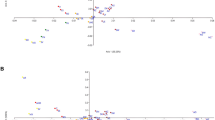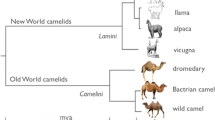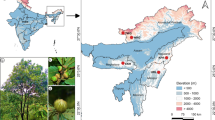Abstract
Using 11 microsatellite markers, data on the genetic structure, levels of variability, and the degree of differentiation of 23 populations (1110 head) of Tuvan coarse-wooled short fat-tailed sheep from different regions of the Tyva Republic were obtained. It was established that at present this autochthonous breed is represented by two main types (mountain and steppe), as well as by numerous local intermediate populations. Despite the detected allelic diversity from 7502 to 10 114, a significant heterozygote deficiency (from 15.3 to 35.6%) was detected in all studied populations. At the same time, interpopulation differences in the group of Tuvan sheep of the steppe type (FST = 0.013–0.153, Jost’s D = 0.029–0.461) were more pronounced than in the group of Tuvan sheep of the mountain type (FST = 0.01–0.071, Jost’s D = 0.029–0.247). The adaptation to different natural and climatic conditions, including a typological composition and productivity of pastures on the territory of Tuva, is one of the possible reasons for the heterogeneous differentiation of the population structure of Tuvan short fat-tailed sheep.




Similar content being viewed by others
REFERENCES
Dongak, M.I., Productivity of Tuvinian short-fat-tailed sheep with different fleece structure, Extended Abstract of Cand. Sci. Dissertation, Moscow, 2011.
Grigoryan, L.N. and Khatataev, S.A., The number and pedigree base of semi-coarse-wool and coarse-wool sheep breeds bred in Russia, Ovtsy, Kozy, Sherst. Delo, 2015, no. 1, pp. 9—12.
Mongush, S.S., Comparative assessment of shearing and wool properties of Tuvinian-Saradzha semi-coarse wool sheep and local Tuvinian sheep, Ovtsy, Kozy, Sherst. Delo, 2018, no. 1, pp. 24—26.
Chysyma, R.B. and Kuzmina, E.E., Innovative development of animal breeding in the Republic of Tyva, Prir. Resur., Sreda O-vo, 2019, no. 1, pp. 59—65.
Tsyrendondokov, N.D. Osnovy ovtsevodstva: biologicheskie osobennosti ovets. Tekhnologiya proizvodstva (Basics of Sheep Breeding: Biological Characteristics of Sheep. Production Technology), Moscow: Rosagropromizdat, 1989.
Kyzyl-ool, I.T., Ovtsevodstvo Tuvinskoi ASSR: istoriko-zootekhnicheskii ocherk (Sheep Breeding in the Tuvinian ASSR: a Historical and Zootechnical Sketch), Kyzyl: Tuvknigoizdat, 1975.
Varvarin, B.G., Pastbishcha i senokosy Tuvinskoi avtonomnoi oblasti (Pastures and Hayfields of the Tuva Autonomous Oblast), issue 2 of Trudy Tuvinskoi gosudarstvennoi sel’skokhozyastvennoi opytnoi stantsii (Proceedings of the State Agricultural Experimental Station), Kyzyl, 1950, pp. 7—85.
Lysenkov, A.A., Pastbishcha Tuvy (Pastures of Tuva), issue 4 of Trudy Tuvinskoi gosudarstvennoi sel’skokhozyastvennoi opytnoi stantsii (Proceedings of the State Agricultural Experimental Station), Kyzyl, 1969.
Sambuu, A.D. and Titlyanova, A.A., The effect of socio-economic development of the Republic of Tyva on its vegetation cover, Fundam. Issled., 2014, no. 11, part 3, pp. 550—555.
Kongar, N.M., Usloviya i nekotorye voprosy razvitiya ovtsevodstva v Tuve (Conditions and Some Issues of the Sheep Breeding Development in Tuva), Kyzyl: Novosti Tuvy, 1995.
Irgit, R.Sh., Lushchenko, A.E., and Oyun, S.M., Characteristics of sheep breeding in the Republic of Tuva by breed composition and zonal-territorial distribution of sheep stock, Usp. Sovrem. Estestvozn., 2011, no. 5, pp. 148—151.
O sostoyanii okruzhayushchei sredy Respubliki Tyva v 2000 g. (On the State of the Environment of the Republic of Tuva in 2000), State Report, Kyzyl: Gosudarstnennyi Komitet Prirodnykh Resursov po Respublike Tyva, 2001.
Ondar, S.N., Formation of wool and pelt productivity of the Tuvinian short-fat-tailed sheep, Extended Abstract of Cand. Sci. Dissertation, Dubrovitsy, 1997.
Biltuev, S.I., Matkhanova, A.V., and Mongush, B.B., Ecological plasticity of the Tuvinian short-fat-tailed sheep, Zootekhniya, 2010, vol. 20, no. 3, pp. 28—33.
Korotkov, V.I. and Rogozhnikov, A.M., Saradzha breed of sheep in Siberia, Ovtsevodstvo, 1974, no. 4, p. 23.
Dvalishvili, V.G. and Shimit, L.D., Sheep breeding in Tyva at the turn of the century, Sostoyanie i zadachi obespecheniya ustoichivogo razvitiya agropromyshlennogo proizvodstva Respubliki Tyva na 2001—2005 gg. (State-of-the-Art and Tasks of Ensuring Sustainable Development of Agro-Industrial Production in the Republic of Tuva for 2001—2005) (Proc. Theor. Ind. Conf.), Novosibirsk, 2002, pp. 119—122.
Yuldashbaev, Yu.A., Dongak, M.I., and Kulikova, K.A., Economically valuable traits in Tuvinian short-fat-tailed sheep and prospects in studying gene polymorphism, Izv. St. Petersburg Gos. Agrar. Univ., 2016, no. 42, pp. 141—148.
Stolpovskii, Yu.A., Shimiit, L.V., Kol, N.V., et al., Analysis of genetic variation and phylogenetic relationships in populations of the Tuvinian short-fat-tailed sheep using ISSR markers, S-kh. Biol., 2009, no. 6, pp. 34—43.
Kulikova, K.S., Characteristics of the Tuvinian short-fat-tailed sheep breed using DNA markers of productive biological characteristics, Extended Abstract of Cand. Sci. Dissertation, Moscow, 2018.
Deniskova, T.E., Dotsev, A.V., Selionova, M.I., et al., Population structure and genetic diversity of 25 Russian sheep breeds based on whole-genome genotyping, Genet. Sel. Evol., 2018, vol. 50, no. 1, p. 29. https://doi.org/10.1186/s12711-018-0399-5
Deniskova, T.E., Abdelmanova, A.S., Dotsev, A.V., et al., PSX-18 high-density genomic description of Russian native sheep breed of the Republic of Tyva, J. Anim. Sci., 2020, vol. 98, no. S4, pp. 453—454.
Arora, R., Bhatia, S., Mishra, B.P., and Joshi, B.K., Population structure in Indian sheep ascertained using microsatellite information, Anim. Genet., 2011, vol. 42, no. 3, pp. 242—250. https://doi.org/10.1111/j.1365-2052.2010.02147.x
Qwabe, O.O., Köster, E., and Visser, C., Genetic diversity and population structure of the endangered Namaqua Afrikaner sheep, Trop. Anim. Health Prod., 2013, vol. 45, no. 2, pp. 511—516. https://doi.org/10.1007/s11250-012-0250-x
Kunene, N.W., Ceccobelli, S., Di Lorenzo, P., et al., Genetic diversity in four populations of Nguni (Zulu) sheep assessed by microsatellite analysis. Ital. J. Anim. Sci., 2014, vol. 13, no. 1, pp. 75—8 2. https://doi.org/10.4081/ijas.2014.3083
Gahlot, K., Purva, M., Maherchandani, S., and Kashyap, S.K., Original research assessment of genetic diversity in Chokla sheep breed of Rajasthan using microsatellite markers, Int. J. Livest. Res., 2018, vol. 8, no. 11, pp. 291—299. https://doi.org/10.5455/ijlr.20171227075019
Lowrey, B., Proffitt, K.M., McWhirter, D.E., and White, P.J., Characterizing population and individual migration patterns among native and restored bighorn sheep (Ovis canadensis), Ecol. Evol., 2019, vol. 9, no. 4, pp. 8829—8839. https://doi.org/10.1002/ece3.5435
Nei, M., Estimation of average heterozygosity and genetic distance from a small number of individuals, Genetics, 1978, vol. 83, pp. 583—590.
Kalinowski, S.T., Counting alleles with rarefaction: private alleles and hierarchical sampling designs, Conserv. Genet., 2004, no. 5, pp. 539—543. https://doi.org/10.1023/B:COGE.0000041021.91777.1a
Weir, B.S. and Cockerham, C.C., Estimating F-statistics for the analysis of population structure, Evolution, 1984, vol. 38, no. 6, pp. 1358—1370. https://doi.org/10.2307/2408641
Jost, L., GST and its relatives do not measure differentiation, Mol. Ecol., 2008, no. 17, pp. 4015—4026. https://doi.org/10.1111/j.1365-294X.2008.03887.x
Huson, D.H. and Bryant, D., Application of phylogenetic networks in evolutionary studies, Mol. Biol. Evol., 2006, vol. 23, no. 2, pp. 254—267. https://doi.org/10.1093/molbev/msj030
R Core Team, R: A Language and Environment for Statistical Computing, Vienna: R Foundation for Statistical Computing, 2018. https://www.R-project.org.
Pritchard, J.K., Stephens, M., and Donnelly, P., Inference of population structure using multilocus genotype data, Genetics, 2000, vol. 155, no. 2, pp. 945—959. https://doi.org/10.1093/genetics/155.2.945
Peakall, R. and Smouse, P.E., GenAlEx 6.5: genetic analysis in Excel. Population genetic software for teaching and research—an update, Bioinformatics, 2012, no. 28, pp. 2537—2539. https://doi.org/10.1093/bioinformatics/bts460
Keenan, K., McGinnity, P., Cross, T.F., et al., DiveRsity: an R package for the estimation and exploration of population genetics parameters and their associated errors, Methods Ecol. Evol., 2013, no. 4, pp. 782—788. https://doi.org/10.1111/2041-210X.12067
State Tribal Register. http://www.mcx.gov.ru. Accessed February 2, 2021.
Andreichik, M.F. and Kalugina, G.V., Osobennosti sinopticheskikh uslovii zagryazneniya Respubliki Tyvy (Features of Synoptic Pollution Conditions in the Republic of Tyva), Kyzyl: TyvGU, 2002.
Amerkhanov, X. Biltuev, C., I., Orus-ool, V.S., and Oorzhak, Ch.M., Features of the Tuvinian short-fat-tailed sheep breeding in environmental conditions of the Republic of Tuva, Ovtsy, Kozy, Sherst. Delo, 2010, no. 2, pp. 8—13.
Mongush, Zh.N., Productive qualities of steppe type sheep of the Tuvinian short-fat-tailed breed depending on their linear affiliation, Cand. Sci. (Agric.) Dissertation, Ulan-Ude, 2014.
Mongush, Zh.N., Comparative characteristics of exterior-productive and some biological features of Tuvinian short-fat-tailed sheep of different types, Extended Abstract of Cand. Sci. Dissertation, Ulan-Ude, 2012.
Chysyma, R.B. and Kuzmina, E.E., Innovative development of animal breeding in the Republic of Tyva, Prir. Resur., Sreda O-vo, 2019, no. 1, pp. 59—65.
Yuldashbaev, Yu.A. and Biche-ool, S.Kh., Tekhnologicheskoe proektirovanie ovtsevodcheskikh krest’yansko-fermerskikh khozyaistv (Technological Design of Sheep-Breeding Peasant Households), Moscow: Ross. Gos. Agrar. Univ., 2009.
Funding
This work was supported by the Russian Science Foundation (project no. 19-76-20061).
Author information
Authors and Affiliations
Corresponding author
Ethics declarations
Conflict of interest. The authors declare that they have no conflicts of interest.
Statement on the welfare of animals. All applicable international, national, and/or institutional guidelines for the care and use of animals were followed.
Additional information
Translated by A. Barkhash
Rights and permissions
About this article
Cite this article
Beketov, S.V., Konorov, E.A., Piskunov, A.K. et al. Population Genetic Characteristics of Tuvan Short Fat-Tailed Sheep. Russ J Genet 58, 326–335 (2022). https://doi.org/10.1134/S1022795422030036
Received:
Revised:
Accepted:
Published:
Issue Date:
DOI: https://doi.org/10.1134/S1022795422030036




